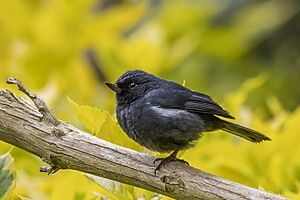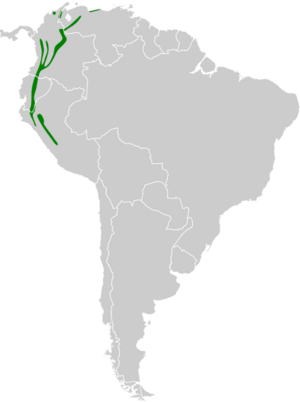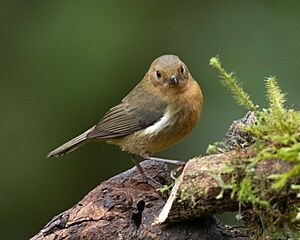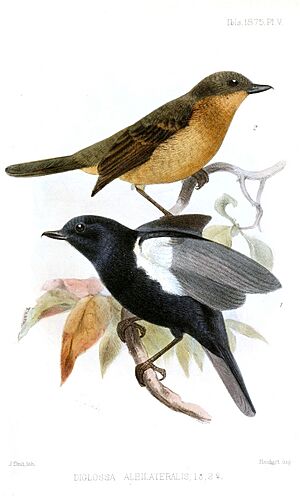White-sided flowerpiercer facts for kids
Quick facts for kids White-sided flowerpiercer |
|
|---|---|
 |
|
| male | |
| Conservation status | |
| Scientific classification | |
| Genus: |
Diglossa
|
| Species: |
albilatera
|
 |
|
The white-sided flowerpiercer (Diglossa albilatera) is a cool little bird found in parts of South America. It's a type of Flowerpiercer, which are birds known for their special beaks. These birds can actually pierce the sides of flowers to get to the sweet nectar inside! You can find them in countries like Colombia, Ecuador, Peru, and Venezuela. They usually live in moist mountain forests or even in areas where forests used to be.
Contents
Understanding the White-Sided Flowerpiercer's Name
Scientists group living things into categories. This is called taxonomy. The white-sided flowerpiercer was first described in 1843. A French bird expert named Frédéric de Lafresnaye gave it the name diglossa albi-latera.
The name Diglossa comes from an old Greek word. It means "double-tongued" or "speaking two languages." The word albilatera comes from Latin. Albus means "white," and lateralis means "sides" or "flanks." So, its name literally means "white-sided" and refers to its unique white markings.
Different Types of White-Sided Flowerpiercers
There are four main types, or subspecies, of the white-sided flowerpiercer. They look very similar but live in slightly different areas:
- D. a. federalis: Found along the coast of northern Venezuela.
- D. a. albilatera: This is the most common type. It lives in the Andes mountains of Venezuela and Colombia. It also lives south into Ecuador and probably northern Peru.
- D. a. schistacea: Found in the far southwest of Ecuador and northwest Peru.
- D. a. affinis: Lives in Peru, east of the Marañón River. It also lives on the west side of the Andes in some southern Peruvian regions.
What Does a White-Sided Flowerpiercer Look Like?
This flowerpiercer is a small bird. It's a bit bigger than a black-capped chickadee but smaller than a great tit. It is about 12 to 13 centimeters (around 5 inches) long. It usually weighs about 10 grams, which is like two quarters.
Male and Female Differences
The male bird is mostly a dark, blackish-gray color. But it has bright white patches on its sides, under its wings. When the bird is sitting, these white spots might be hard to see. However, when it flaps its wings, you can see a quick flash of white!
Female flowerpiercers are different. They are olive-brown on their backs and buffy-brown underneath. They also have the same white patches on their sides as the males. Both males and females have dark brown eyes. Their beaks are blackish, and their legs are gray.
Young Flowerpiercers
Young males look a lot like females. But their feathers are a duller brown. They might have blurry streaks on their chest. Very young birds, called juveniles, are dark gray-brown. Their feathers have dark tips, which makes them look a bit scaly.




